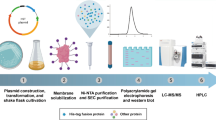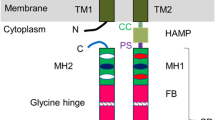Abstract
A putative copper ion-sensing transcriptional regulator CopR (TON_0836) from Thermococcus onnurineus NA1 was characterized. The CopR protein consists of a winged helix-turn-helix DNA-binding domain in the amino-terminal region and a TRASH domain that is assumed to be involved in metal ion-sensing in the carboxyl-terminal region. The CopR protein was most strongly bound to a region between its own gene promoter and a counter directional promoter region for copper efflux system CopA. When the divalent metals such as nickel, cobalt, copper, and iron were present, the CopR protein was dissociated from the target promoters on electrophoretic mobility shift assay (EMSA). The highest sensible ion is copper which affected protein releasing under 10 µM concentrations. CopR recognizes a significant upstream region of TATA box on CopR own promoter and acts as a transcriptional repressor in an in vitro transcription assay. Through site-directed mutagenesis of the DNA-binding domain, R34M mutant protein completely lost the DNA-binding activity on target promoter. When the conserved cysteine residues in C144XXC147 motif 1 of the TRASH domain were mutated into glycine, the double cysteine residue mutant protein alone lost the copper-binding activity. Therefore, CopR is a copper-sensing transcriptional regulator and acts as a repressor for autoregulation and for a putative copper efflux system CopA of T. onnurineus NA1.








Similar content being viewed by others
References
Aravind L, Koonin EV (1999) DNA-binding proteins and evolution of transcription regulation in the archaea. Nucleic Acids Res 27:4658–4670. https://doi.org/10.1093/nar/27.23.4658
Bae SS, Kim YJ, Yang SH, Lim JK, Jeon JH, Lee HS, Kang SG, Kim SJ, Lee JH (2006) Thermococcus onnurineus sp. nov., a hyperthermophilic archaeon isolated from a deep-sea hydrothermal vent area at the PACMANUS field. J Microbiol Biotechnol 16:1826–1831
Bae SS, Kim TW, Lee HS, Kwon KK, Kim YJ, Kim MS, Lee JH, Kang SG (2012) H2 production from CO, formate or starch using the hyperthermophilic archaeon, Thermococcus onnurineus. Biotechnol Lett 34:75–79. https://doi.org/10.1007/s10529-011-0732-3
Baker-Austin C, Dopson M, Wexler M, Sawers RG, Bond PL (2005) Molecular insight into extreme copper resistance in the extremophilic archaeon ‘Ferroplasma acidarmanus’ Fer1. Microbiology 151:2637–2646. https://doi.org/10.1099/mic.0.28076-0
Bell SD (2005) Archaeal transcriptional regulation—variation on a bacterial theme? Trends Microbiol 13:262–265. https://doi.org/10.1016/j.tim.2005.03.015
Bell SD, Cairns SS, Robson RL, Jackson SP (1999) Transcriptional regulation of an archaeal operon in vivo and in vitro. Mol Cell 4:971–982
Brinkman AB, Ettema TJ, de Vos WM, van der Oost J (2003) The Lrp family of transcriptional regulators. Mol Microbiol 48:287–294
Busenlehner LS, Pennella MA, Giedroc DP (2003) The SmtB/ArsR family of metalloregulatory transcriptional repressors: structural insights into prokaryotic metal resistance. FEMS Microbiol Rev 27:131–143. https://doi.org/10.1016/S0168-6445(03)00054-8
Cho S, Kim MS, Jeong Y, Lee BR, Lee JH, Kang SG, Cho BK (2017) Genome-wide primary transcriptome analysis of H2-producing archaeon Thermococcus onnurineus NA1. Sci Rep 7:43044. https://doi.org/10.1038/srep43044
Coombs JM, Barkay T (2005) New findings on evolution of metal homeostasis genes: evidence from comparative genome analysis of bacteria and archaea. Appl Environ Microbiol 71:7083–7091. https://doi.org/10.1128/AEM.71.11.7083-7091.2005
Edwards KJ, Bond PL, Gihring TM, Banfield JF (2000) An archaeal iron-oxidizing extreme acidophile important in acid mine drainage. Science 287:1796–1799. https://doi.org/10.1126/science.287.5459.1796
Ettema TJG, Huynen MA, de Vos WM, van der Oost J (2003) TRASH: a novel metal-binding domain predicted to be involved in heavy-metal sensing, trafficking and resistance. Trends Biochem Sci 28:170–173. https://doi.org/10.1016/S0968-0004(03)00037-9
Ettema TJG, Brinkman AB, Lamers PP, Kornet NG, de Vos WM, van der Oost J (2006) Molecular characterization of a conserved archaeal copper resistance (cop) gene cluster and its copper-responsive regulator in Sulfolobus solfataricus P2. Microbiology 152:1969–1979. https://doi.org/10.1099/mic.0.28724-0
Geiduschek EP, Ouhammouch M (2005) Archaeal transcription and its regulators. Mol Microbiol 56:1397–1407. https://doi.org/10.1111/j.1365-2958.2005.04627.x
Gindner A, Hausner W, Thomm M (2014) The TrmB family: a versatile group of transcriptional regulators in Archaea. Extremophiles 18:925–936. https://doi.org/10.1007/s00792-014-0677-2
Hill PJ, Cockayne A, Landers P, Morrissey JA, Sims CM, Williams P (1998) SirR, a novel iron-dependent repressor in Staphylococcus epidermidis. Infect Immun 66:4123–4129
Kanai T, Akerboom J, Takedomi S, van de Werken HJ, Blombach F, van der Oost J, Murakami T, Atomi H, Imanaka T (2007) A global transcriptional regulator in Thermococcus kodakaraensis controls the expression levels of both glycolytic and gluconeogenic enzyme-encoding genes. J Biol Chem 282:33659–33670. https://doi.org/10.1074/jbc.M703424200
Kim YJ, Lee HS, Kim ES, Bae SS, Lim JK, Matsumi R, Lebedinsky AV, Sokolova TG, Kozhevnikova DA, Cha S-S, Kim S-J, Kwon KK, Imanaka T, Atomi H, Bonch-Osmolovskaya EA, Lee J-H, Kang SS (2010) Formate-driven growth coupled with H2 production. Nature 467:352–355. https://doi.org/10.1038/nature09375
Kim M, Park S, Lee S-J (2016) Global transcriptional regulator TrmB family members in prokaryotes. J Microbiol 54:639–645. https://doi.org/10.1007/s12275-016-6362-7
Lee S-J, Surma M, Hausner W, Thomm M, Boos W (2008) The role of TrmB and TrmB-like transcriptional regulators for sugar transport and metabolism in the hyperthermophilic archaeon Pyrococcus furiosus. Arch Microbiol 190:247–256. https://doi.org/10.1007/s00203-008-0378-2
Lemmens L, Maklad HR, Bervoets I, Peeters E (2019) Transcription regulators in archaea: homologies and differences with bacterial regulators. J Mol Biol. https://doi.org/10.1016/j.jmb.2019.05.045
Louvel H, Kanai T, Atomi H, Reeve JN (2009) The Fur iron regulator-like protein is cryptic in the hyperthermophilic archaeon Thermococcus kodakaraensis. FEMS Microbiol Lett 295:117–128. https://doi.org/10.1111/j.1574-6968.2009.01594.x
Osman D, Cavet JS (2010) Bacterial metal-sensing proteins exemplified by ArsR-SmtB family repressors. Nat Prod Rep 27:668–680. https://doi.org/10.1039/b906682a
Peeters E, Charlier D (2010) The Lrp family of transcription regulators in archaea. Archaea. https://doi.org/10.1155/2010/750457
Rademacher C, Masepohl B (2012) Copper-responsive gene regulation in bacteria. Microbiology 158:2451–2464. https://doi.org/10.1099/mic.0.058487-0
Tao X, Schiering N, Zeng HY, Ringe D, Murphy JR (1994) Iron, DtxR, and the regulation of diphtheria toxin expression. Mol Microbiol 14:191–197
Thompson JD, Gibson TJ, Plewniak F, Jeanmougin F, Higgins DG (1997) The CLUSTAL_X windows interface: flexible strategies for multiple sequence alignment aided by quality analysis tools. Nucleic Acids Res 25:4876–4882. https://doi.org/10.1093/nar/25.24.4876
Villafane A, Voskoboynik Y, Ruhl I, Sannino D, Maezato Y, Blum P, Bini E (2011) CopR of Sulfolobus solfataricus represents a novel class of archaeal-specific copper-responsive activators of transcription. Microbiology 157:2808–2817. https://doi.org/10.1099/mic.0.051862-0
Völlmecke C, Drees SL, Reimann J, Albers SV, Lübben M (2012) The ATPases CopA and CopB both contribute to copper resistance of the thermoacidophilic archaeon Sulfolobus solfataricus. Microbiology 158:1622–1633. https://doi.org/10.1099/mic.0.055905-0
Acknowledgements
We thank Drs Kanai T and Atomi H for in vitro transcription assay with transcription factors of Thermococcus kodakarensis at Kyoto University. This work was supported by the ‘Biohydrogen production from hyperthermophiles’ program of the Korea Institute of Ocean Science and Technology (KIOST) and by the National Research Foundation of Korea (2010-0010779).
Author information
Authors and Affiliations
Corresponding author
Ethics declarations
Conflict of interest
The authors declare that they have no conflict of interest.
Additional information
Publisher's Note
Springer Nature remains neutral with regard to jurisdictional claims in published maps and institutional affiliations.
Electronic supplementary material
Below is the link to the electronic supplementary material.
Rights and permissions
About this article
Cite this article
Kim, SY., Jeong, H.J., Kim, M. et al. Characterization of the copper-sensing transcriptional regulator CopR from the hyperthermophilic archeaon Thermococcus onnurineus NA1. Biometals 32, 923–937 (2019). https://doi.org/10.1007/s10534-019-00223-2
Received:
Accepted:
Published:
Issue Date:
DOI: https://doi.org/10.1007/s10534-019-00223-2




